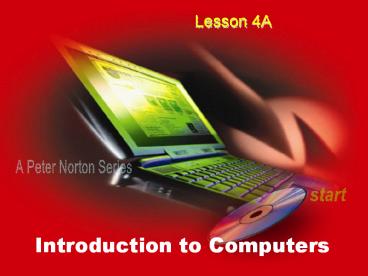Introduction to Computers PowerPoint PPT Presentation
Title: Introduction to Computers
1
Introduction to Computers
- Lesson 4A
2
Decimal Number System
- Called base 10 because 10 symbols are available
3
Binary Number System
- Computers function in base 2, or the binary
number system, where there are only two values
4
Bit
- A combination of binary digit
- The smallest possible unit of data a computer can
recognize or use
5
Byte
- A group of eight bits
6
Text Codes
- EBCDIC
- ASCII
- Unicode
7
CPU
- The CPU is the computers brain that
manipulates data
8
CPUs Two Basic Parts
- Control unit
- Arithmetic logic unit
9
Control Unit
- Manages all the computers resources
10
Arithmetic Logic Unit
- Performs the CPUs arithmetic and logical
operations
11
Machine Cycle
- The completed series of steps the CPU takes to
execute an instruction
12
Machine Cycles Two Cycles
- Instruction cycle
- Execution cycle
13
Instruction Cycle
- Fetching
- Decoding
14
Execution Cycle
- Executing
- Storing
15
Millions of Instructions Per Second (MIPS)
- The CPU performance measurement
16
Pipelining
- Also called pipeline processing
- The control unit begins a new machine cycle
before the current cycle is completed
17
Memory
- Allows the CPU to store and retrieve data quickly
18
Two Kinds of Memory
- Read-only memory (ROM) nonvolatile
- Random-access memory (RAM) volatile
19
ROM
- ROM always holds the same data, for example the
computers start-up instructions
20
RAM
- RAMs job is to hold programs and data while they
are in use - RAM can change instantly
21
Other Kinds of RAM
- Dynamic RAM (DRAM)
- DRAM Variations
- Static RAM (SRAM)
22
Factors Affecting Processing Speed
- Registers
- Memory and computing power
- System clock
- The bus
- The databus
- The address bus
- Cache memory
23
Bus Types
- Industry standard architecture (ISA) bus
- Local bus
- Peripheral component interconnect (PCI) bus
- Accelerated Graphics Port (AGP) bus
- Universal Serial Bus (USB)
- IEEE 1394 (FireWire)
24
Data Transfer Rate
- The amount of data buses can transfer in a second
- Measured in megabits per second (Mbps) or
megabytes per second (MBps)
25
Cache memory
- Speeds processing by storing frequently used data
or instructions in its high-speed memory
26
Lesson 4A
- Transforming Data Into Information
27
Review Questions
- What is the difference between a bit and a byte?
- What are the CPUs two basic parts?
- What is a machine cycle?
- What is the difference between ROM and RAM?

